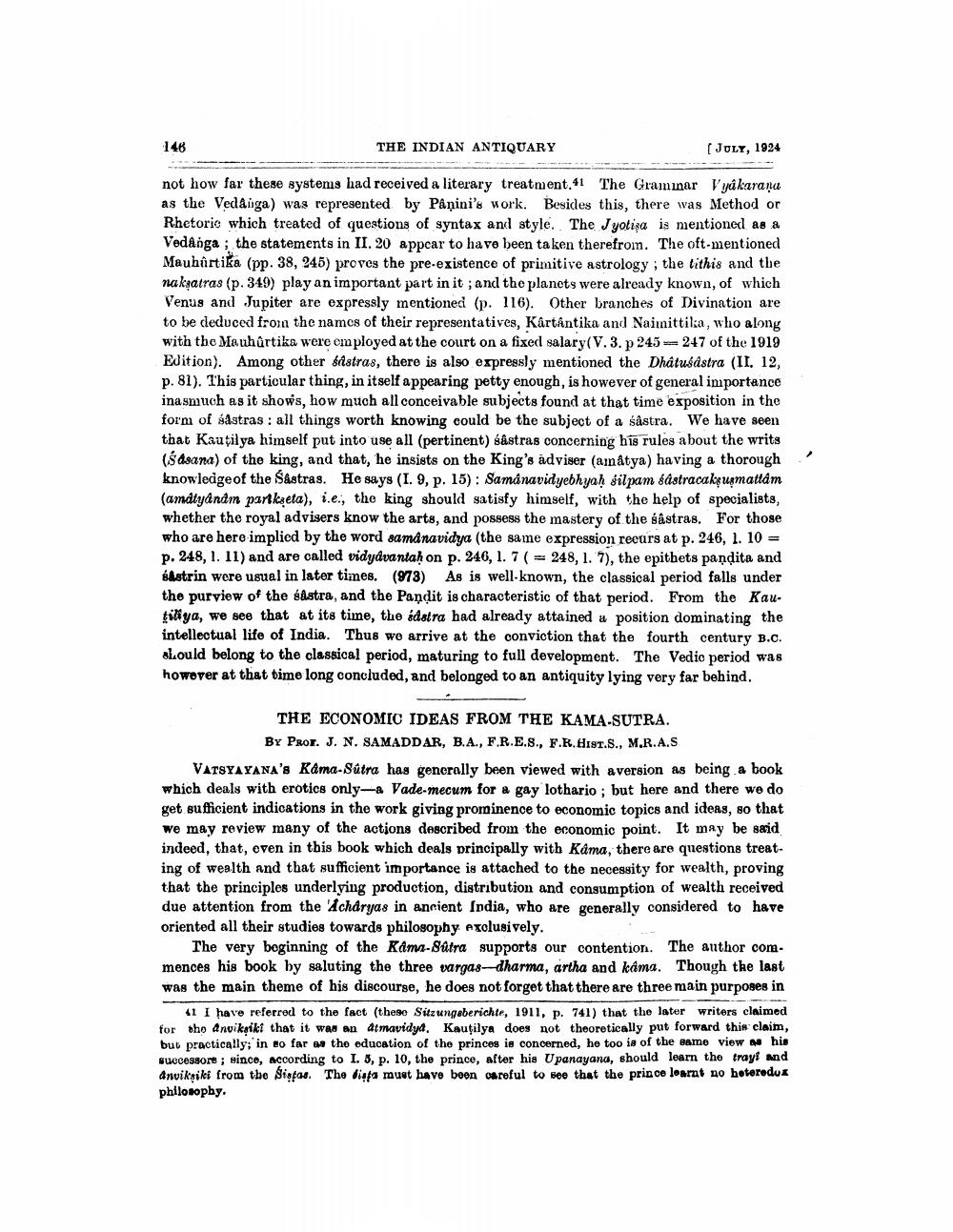________________
146
THE INDIAN ANTIQUARY
[JULY, 1924
not how far these systems had received a literary treatment.41 The Grammar Vyakarana as the Vedâiga) was represented by Pânini's work. Besides this, there was Method or Rhetoric which treated of questions of syntax and style. The Jyotisa is mentioned as a Vedanga; the statements in II. 20 appear to have been taken therefrom. The oft-mentioned Mauhârtika (pp. 38, 245) proves the pre-existence of primitive astrology; the tithis and the nakṣatras (p. 349) play an important part in it; and the planets were already known, of which Venus and Jupiter are expressly mentioned (p. 116). Other branches of Divination are to be deduced from the names of their representatives, Kârtântika and Naimittika, who along with the Mauhûrtika were employed at the court on a fixed salary(V. 3. p 245 247 of the 1919 Edition). Among other sastras, there is also expressly mentioned the Dhâtusastra (II. 12, p. 81). This particular thing, in itself appearing petty enough, is however of general importance inasmuch as it shows, how much all conceivable subjects found at that time exposition in the form of sastras: all things worth knowing could be the subject of a sâstra. We have seen that Kautilya himself put into use all (pertinent) sâstras concerning his rules about the writs (Sasana) of the king, and that, he insists on the King's adviser (amâtya) having a thorough knowledge of the Sastras. He says (I. 9, p. 15): Samânavidyebhyaḥ silpam sastracakṣumattâm (amátyánám partkseta), i.e., the king should satisfy himself, with the help of specialists, whether the royal advisers know the arts, and possess the mastery of the sâstras. For those who are here implied by the word samânavidya (the same expression recurs at p. 246, 1. 10 = p. 248, 1. 11) and are called vidyavantaḥ on p. 246, 1. 7 (248, 1. 7), the epithets pandita and sastrin were usual in later times. (973) As is well-known, the classical period falls under the purview of the sastra, and the Pandit is characteristic of that period. From the Kautiliya, we see that at its time, the idstra had already attained a position dominating the intellectual life of India. Thus we arrive at the conviction that the fourth century B.C. should belong to the classical period, maturing to full development. The Vedic period was however at that time long concluded, and belonged to an antiquity lying very far behind.
THE ECONOMIC IDEAS FROM THE KAMA-SUTRA.
BY PROF. J. N. SAMADDAR, B.A., F.R.E.S., F.R. HIST.S., M.R.A.S
VATSYAYANA'S Kama-Sutra has generally been viewed with aversion as being a book which deals with erotics only-a Vade-mecum for a gay lothario; but here and there we do get sufficient indications in the work giving prominence to economic topics and ideas, so that we may review many of the actions described from the economic point. It may be said indeed, that, even in this book which deals principally with Kama, there are questions treating of wealth and that sufficient importance is attached to the necessity for wealth, proving that the principles underlying production, distribution and consumption of wealth received due attention from the 'Acharyas in ancient India, who are generally considered to have oriented all their studies towards philosophy exclusively.
The very beginning of the Kama-Sutra supports our contention. The author commences his book by saluting the three vargas-dharma, artha and kama. Though the last was the main theme of his discourse, he does not forget that there are three main purposes in
41 I have referred to the fact (these Sitzungsberichte, 1911, p. 741) that the later writers claimed for the anviksiki that it was an atmavidya. Kautilya does not theoretically put forward this claim, but practically; in so far as the education of the princes is concerned, he too is of the same view as his successore; since, according to I. 5, p. 10, the prince, after his Upanayana, should learn the tray? and anviksiki from the Sistas. The disfa must have been careful to see that the prince learnt no hetereduz philosophy.




